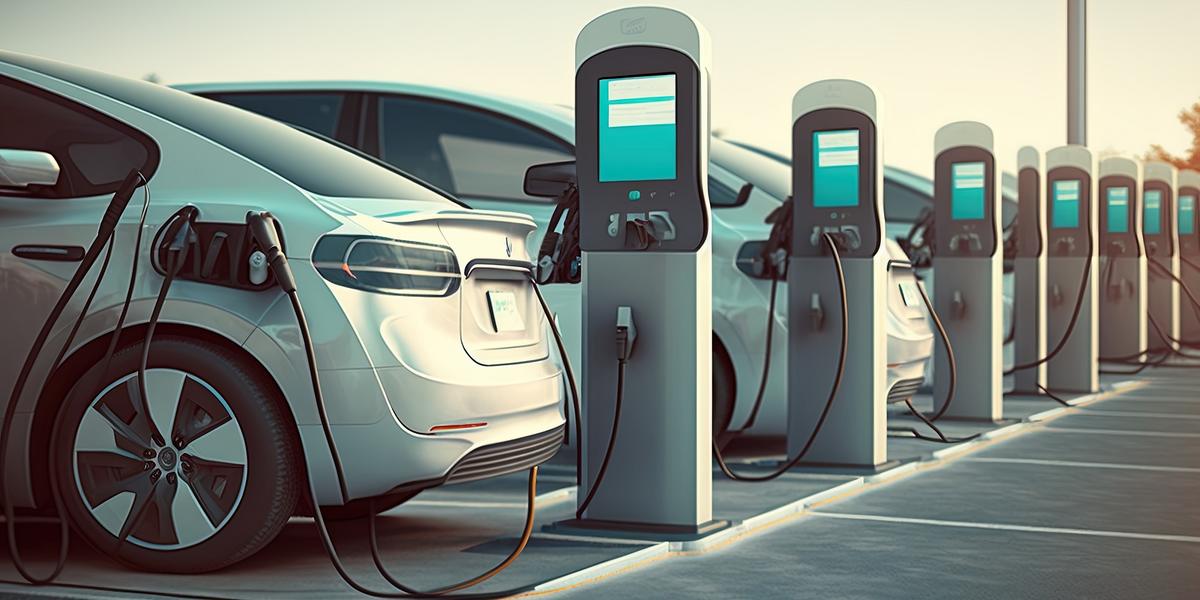Electric vehicle charging is no longer a hurdle to going electric! Buckle up as we explore the top 10 advancements redefining the landscape of EV charging infrastructure in 2024. From lightning-fast charging stations to charging on the go, these innovations are paving the way for a seamless and sustainable electric driving experience. We’ll delve into the growing presence of ultra-fast chargers that significantly boost range in minutes, easing concerns about long-distance travel. We’ll also explore how governments and private companies are expanding charging networks across urban, suburban, and even rural areas, ensuring accessibility for all EV drivers. Stay tuned as we explore the rise of standardization in charging systems, the potential of vehicle-to-grid integration, and the exciting possibilities of wireless charging!
Also, read: Top 10 Electric Vehicle Technologies
Powering the Future: Top 10 Advancements in Electric Vehicle Charging Infrastructure in 2024
Electric vehicles are zooming onto the scene, but charging infrastructure needs to keep pace. Fear not, eco-conscious drivers! This blog dives into the top 10 advancements redefining EV charging in 2024. From ultra-fast stations slashing charging times to charging at the mall while you shop, discover how innovation is making electric transportation easier, more accessible, and downright convenient. Buckle up and get ready to see the future of EV charging!

1. Ultra-Fast Charging Stations Power Up the EV Revolution
One of the biggest hurdles to electric vehicle (EV) adoption has been “range anxiety,” the fear of running out of juice before reaching a charging station. But 2024 is witnessing a game-changer: the rise of ultra-fast charging stations. These powerful stations deliver enough juice to significantly boost an EV’s range in under 20 minutes, making long trips a breeze. This cuts down on charging times dramatically compared to traditional stations and is revolutionizing EV road trips.
With ultra-fast charging becoming more common, not only will EV ownership be more convenient, but it will also quell the anxieties of potential EV drivers, accelerating the transition to a cleaner and more sustainable transportation future.
Also, read: Top 10 Warning Signs Your Electric Vehicle Needs Service
2. Wider Availability of Public Chargers
One of the most significant advancements in EV charging infrastructure in 2024 is the wider availability of public chargers. Governments and private companies are recognizing the need to support the growing EV market and are investing heavily in expanding charging networks. This expansion is happening in both urban and suburban areas, making it easier for EV owners to find a place to charge their vehicles wherever they go.
Additionally, initiatives are underway to bridge the gap in rural areas, ensuring that EV drivers have access to charging options on long trips. This increased accessibility is crucial for overcoming ‘range anxiety’ and encouraging wider adoption of electric vehicles.
3. Focus on Rural Charging
Historically, electric vehicle (EV) charging infrastructure has been concentrated in urban and suburban areas. This has created a significant barrier to EV adoption in rural communities, where residents often have limited access to charging stations. However, 2024 is witnessing a growing focus on bridging this gap.
Several initiatives are underway to expand charging access in rural areas. Governments are investing in grants and subsidies to encourage the installation of chargers in underserved communities. Private companies are also getting involved, recognizing the potential of the rural EV market. Utilities are collaborating with local governments to identify strategic locations for chargers, ensuring they are placed along major highways and in areas with high EV ownership.
This focus on rural charging is essential for achieving widespread EV adoption. By making charging more accessible in all regions, we can create a more equitable and sustainable transportation system.
Also, read: Top 10 Tips for Extending Your Electric Vehicle’s Battery Life
4. Standardization Efforts Gain Momentum
Confusion over charger types and compatibility used to be a major hurdle for EV adoption. Thankfully, 2024 is seeing a significant push towards universal charging standards. Imagine a world where you can pull into any charging station, regardless of brand, and know your EV will juice up seamlessly. This dream is inching closer thanks to industry-wide efforts to establish common ground on connector types, communication protocols, and data exchange formats.
Standardizing charging systems will not only eliminate range anxiety caused by compatibility concerns for drivers, but it will also streamline manufacturing and maintenance processes for charging station operators. Ultimately, it’s a win-win for EV drivers, manufacturers, and the environment, paving the way for a more robust and efficient charging infrastructure that can support the growing EV revolution.
5. Smart Charging Technology Takes Hold
Forget mindless plugging in! 2024 is the year smart charging takes the wheel of EV charging infrastructure. These intelligent systems are like having a personal charging assistant. They analyze factors like electricity prices, grid conditions, and even your driving habits. This lets them optimize charging times to save you money and reduce strain on the power grid. Imagine charging your car at the cheapest electricity rates, automatically avoiding peak hours.
Smart charging can even factor in weather forecasts if you have solar panels at home, ensuring your top-up coincides with peak sunshine hours. This two-way communication between car and charger is a game-changer for EV ownership, promoting efficiency, cost savings, and a more sustainable energy ecosystem. So, the next time you plug in, remember, that it’s not just your car that’s getting smarter—the entire charging infrastructure is evolving alongside it.
Also, read: Top 10 Myths About Electric Vehicle Maintenance Busted
6. Vehicle-to-Grid (V2G) Integration Expands
Imagine your electric vehicle (EV) not just using clean energy, but also contributing to a more stable and sustainable grid. That’s the promise of V2G integration, a rapidly developing technology that allows EVs to act as mobile energy storage units. With V2G, your parked EV can send excess power back to the grid during peak demand periods, helping to balance electricity loads and even earning you credits or compensation from your utility company.
This two-way flow of energy isn’t just beneficial for your wallet; it also reduces the strain on traditional power plants, creates a more efficient use of renewable energy sources like solar and wind, and paves the way for a more resilient and eco-friendly grid. With V2G technology still evolving, pilot programs are demonstrating its potential, and as the number of EVs on the road continues to grow, V2G integration is poised to become a game-changer for the future of clean transportation and a smarter, greener power grid.
7. Wireless Charging Gets Closer to Reality
Imagine a world where topping off your electric car’s battery is as simple as pulling into a parking spot. No more fumbling with cords or searching for compatible plugs. This dream is inching closer to reality thanks to pioneering advancements in wireless charging technology. Pilot programs are testing inductive charging systems, which use magnetic fields to transfer energy between a charging pad embedded in the ground and a receiver installed on the underside of your EV. This eliminates the need for physical connections and promises a future of seamless, hands-free charging.
While challenges like slower charging speeds compared to traditional methods remain, the benefits are undeniable. Wireless charging offers increased convenience, reduces wear and tear on charging ports, and could even improve safety by eliminating exposed electrical components. With major automakers like Tesla showing interest and the growing momentum behind standardization, 2024 could be a pivotal year for wireless EV charging. The technology holds immense potential to revolutionize the electric vehicle experience, making charging as effortless as parking your car.
Also, read: Top 10 Reasons to Buy Renault Megane
8. Focus on Sustainability in Charging Infrastructure
The electric vehicle revolution is gaining momentum, but ensuring a truly eco-friendly future requires sustainable charging solutions. 2024 is witnessing a significant push in this direction. Charging stations are incorporating renewable energy sources like solar panels to power EV charging, reducing reliance on fossil fuels and greenhouse gas emissions. This not only lessens the environmental impact of EVs but also paves the way for off-grid or partially grid-independent charging stations, especially in remote locations.
Additionally, the focus is shifting towards utilizing recycled materials in charger construction, minimizing resource extraction and the associated environmental burden. By embracing renewable energy and recycled materials, the EV charging infrastructure is transforming into a greener and more sustainable system, ensuring a cleaner future alongside the rise of electric vehicles.
9. The Rise of the “Charge-While-You-Park” Model
In a significant shift for electric vehicle (EV) ownership, the “Charge-While-You-Park” model is rapidly emerging as a game-changer. Businesses like shopping malls, restaurants, and movie theaters are strategically installing EV charging stations on their premises. This provides EV drivers with a convenient way to top up their batteries while they shop, dine, or enjoy entertainment. The benefits are multifaceted. Customers extend their dwell time at businesses, boosting sales and revenue.
EV drivers experience reduced ‘range anxiety’ knowing they can conveniently charge while they go about their errands. This innovative approach fosters a symbiotic relationship between businesses and EV owners, accelerating the widespread adoption of electric vehicles and paving the way for a more sustainable future.
Also, read: Ten Signs That Your Car’s Battery is Dying
10. Data-Driven Insights for Better Management
Data powers the future of EV charging infrastructure. Advanced analytics are revolutionizing how charging networks are managed. Imagine this: by analyzing usage patterns, we can strategically place chargers where they’re needed most, ensuring even distribution and reducing wait times. Data also predicts peak usage times, allowing utility companies to optimize grid load and prevent energy strain. But it gets even better.
Real-time data allows for dynamic pricing models, where charging costs fluctuate based on electricity demand. This incentivizes off-peak charging, promoting efficient energy use. Furthermore, data empowers predictive maintenance, identifying potential issues with chargers before they cause disruptions. In essence, data-driven insights are the secret sauce for a future-proof EV charging network, ensuring a smooth, sustainable, and ever-evolving experience for EV drivers.
FAQs
Q. What are the EV predictions for 2024?
In 2024, EV Volumes expects 16.6 million EV sales, equating to a 19.2% share of the light-vehicle market. Therefore, plug-in deliveries are forecast to grow by 17%, while the total market is only expected to improve by 1%.
Also, read: Ten best luxury cars in the world
Q. What is the future technology for EV charging?
V2G technology is another frontier in EV charging, allowing EVs to not only draw power from the grid but also supply energy back to it. This bidirectional flow of energy can help stabilize the grid during peak demand and store excess renewable energy, turning EVs into mobile power sources.
Q. How much faster are ultra-fast charging stations compared to regular chargers?
Ultra-fast charging stations can add significant range (often around 100–200 miles) in under 20 minutes, compared to several hours for Level 2 chargers, which are commonly found in public places.
Q. Will there be enough chargers for all the EVs on the road?
Governments and private companies are rapidly expanding charging networks, in urban and rural areas. Additionally, initiatives like smart charging and V2G technology can help manage the growing electricity demand.
Also, read: Top 10 best-selling cars in the world
Q. When can I expect to see wireless charging for EVs?
Wireless charging technology is still under development, but pilot programs are underway. While widespread adoption might take a few more years, it has the potential to significantly improve charging convenience.
Q. How can I find out where the nearest EV charger is located?
Many EV manufacturers and charging network providers offer mobile apps that allow you to locate charging stations, check their availability, and even initiate charging sessions remotely.
Q. Is there a way to charge my EV with renewable energy?
A growing number of charging stations are integrating solar panels or other renewable energy sources to power the charging process, reducing reliance on the traditional grid.
Conclusion
The electric vehicle revolution is fueled by innovation in charging infrastructure. From lightning-fast charging stations to eco-friendly power sources and strategic placement, advancements in 2024 are making EVs more practical than ever. With convenient charging options readily available, range anxiety becomes a thing of the past, paving the way for a cleaner and more sustainable transportation future. 2024 has been a pivotal year for the electric vehicle charging infrastructure. Significant strides have been made in enhancing charging speeds, expanding charging networks, and integrating innovative technologies. The rapid adoption of EVs has necessitated the development of robust and efficient charging infrastructure.
From the introduction of ultra-fast charging stations to the deployment of wireless charging solutions, the industry has witnessed remarkable progress. The focus on standardization and interoperability has further accelerated the growth of the electric vehicle charging infrastructure in 2024. As we move forward, it is imperative to continue investing in research and development to address the challenges associated with large-scale EV adoption. By fostering collaboration between governments, industry stakeholders, and consumers, we can collectively shape the future of electric vehicle charging infrastructure and drive the transition to a sustainable and electrified transportation system.
Also, read: Top Ten Tips for Driving Safely in Winter Weather


































